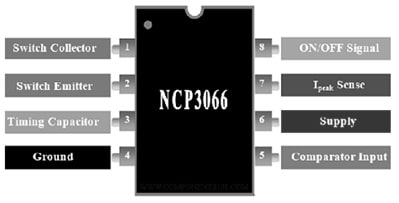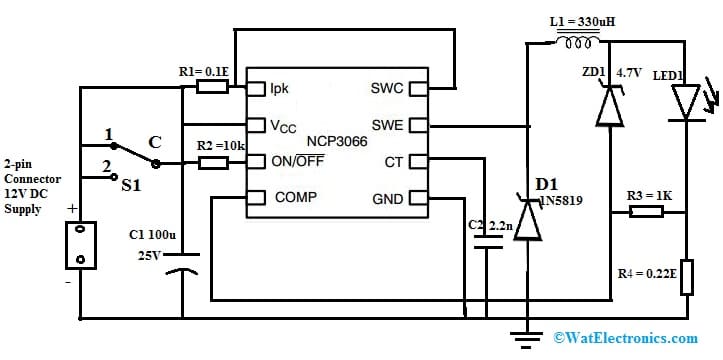The constant current regulators are circuits that are used to achieve a stable current supply in Power Electronics. These regulators have been used in a number of applications over the years but at present, they have achieved a type of ubiquitous position because of their significant applications within LED lighting. The current regulator operation is the same as the voltage regulator with the main difference being the parameter they adjust & the amount they differ to supply their o/p. The current in a voltage regulator is changed to attain the necessary voltage level whereas current regulators typically involve variations within resistance/voltage to get the necessary current output. This article discusses an overview of NCP3066 constant current regulator – features & its applications.
What is NCP3066 Constant Current Regulator?
The NCP3066 is a monolithic constant current regulator used to deliver stable current to provide for high brightness light emitting diodes. This current regulator has 235 mV of extremely low feedback voltage that is mainly utilized to control the normal current LED string. Additionally, this regulator includes 40 V of wide i/p voltage to allow it to work from a 12 Vac/a 12 to 36 Vdc supply, used in lighting and rechargeable batteries.
This regulator is configured in Buck (Step−Down), Boost (Step−Up) & Voltage−Inverting topologies through less number of external components. The ON/OFF pin of this regulator simply provides PWM dimming ability otherwise a low-power shutdown mode. If you are looking for a stable current DC to DC regulator equal to 1.5Amp, then this current regulator might be the right choice. This IC is used in automotive lighting, marine, and any handy lighting-based applications.
Pin Configuration:
The pin configuration of the NCP3066 constant current regulator is shown below. This IC includes 8 pins where every pin and its function is discussed below.

NCP3066 Constant Current Regulator Pin Configuration
- Pin1 (Switch Collector): It is an internal Darlington switch collector pin.
- Pin2 (Switch Emitter): It is an internal Darlington switch emitter pin.
- Pin3 (Timing Capacitor): It is a timing capacitor for the oscillator pin.
- Pin4 (GND): This is a GND pin of all internal circuits.
- Pin5 (Inverting pin of Comparator): It is an inverting i/p pin of a comparator.
- Pin6 (Vcc): It is an i/p voltage of the regulator.
- Pin7 (Ipk Sense): It is a sensing pin of peak current.
- Pin (ON/OFF): It is an ON/OFF pin.
Features & Specifications:
The features and specifications of the NCP3066 constant current regulator are discussed below.
- It is a monolithic constant current regulator IC.
- Its Input voltage or Vin ranges from 3V – 40V.
- It is an integrated 1.5Amps switch.
- It has 235mV of low feedback voltage.
- Its high operating frequency is upto 150 kHz.
- It has logic-level shutdown capacity.It is analog & PWM dimmable.
It is available in SOIC, DFN & 8-pin - DIP-packages.
- It has analog & digital PWM dimming capacity.
- These regulator devices are Pb−Free.
- It has internal thermal shutdown capacity through hysteresis.
- It requires no control loop compensation.
- Its adjustable frequency operation is upto 250 kHz.
- It has cycle-by-cycle current limiting.
Alternatives & Equivalents
Alternative NCP3066 constant current regulators are; LM5008, XL6009 & LM3407 whereas Equivalent NCP3066 constant current regulators are; A6211 & NCP3065.
Automatic Light in Scooter Storage Compartment
In scooters, the storage box below the seat normally doesn’t contain a light. So it is very hard sometimes to search for items at night time. To overcome this problem here is a solution that automatically turns on a light once the scooter storage box is opened.
The automatic light in the scooter storage compartment using NCP3066 constant current regulator is shown below. The required components to make this circuit mainly include; NCP3066 IC, D1 (1N5819 schottky diode), ZD1 (4.7volts zener diode), 1Watt white LED (LED1), resistors -0.1ohm, 1kohm, 10kohm, 0.22ohm, capacitors – 100uF, 2.2nF ceramic, S1 push limit switch,330uH inductor (L1), two pin connector and 12V DC supply. Connect the circuit as per the circuit shown below.

Automatic Light with NCP3066 IC for Scooter Storage Compartment
Working
In the above circuit, IC1 is connected as a constant-current driver within buck topology for driving LED1. Here, a constant-current buck driver circuit can be formed through IC1, D1, L1 & R current-sensing resistor, C1 capacitor performs as a buffer, C2 capacitor decides the circuit’s operating frequency. The 2.2nF C2 capacitor generates 150 kHz of oscillating frequency.
The S1 limit switch on the wall of the scooter seat compartment must be connected in such a way that the lever of the switch remains pushed once the scooter seat is in its usual position. So this detaches the S1 switch’s NC pin & at pin-8 of the regulator, there is no voltage available, so LED1 will be OFF.
Once the scooter seat is opened, then the lever of the S switch is released & connects the NC pin & detaches the NO pin with the Common. Therefore, pin-8 of the regulator will get a positive supply, so that LED1 will glow. Here, the R3 resistor & ZD1 Zener diode simply keeps the circuit protected from a fault condition.
Advantages
The advantages of the NCP3066 constant current regulator are shown below.
- NCP3066 is mainly designed for the regulation of current.
- Its operating frequency is up to 250kHz.
- It has logic-level shutdown capacity.
- The feedback voltage is about 235 mV.
- It has stable current regulations.
- It has inner thermal shutdown through hysteresis.
- It has analog & digital PWM dimming capacities.
- It has a simple design.
- It has size and efficiency optimization.
- It has better safety features.
- It has a low power supply below <100µA.
- It decreases the size & cost by removing the output capacitor.
- It allows the low-cost/small sense resistor.
NCP3066 Constant Current Regulator Applications
The applications of NCP3066 constant current regulator are discussed below.
- The NCP3066 constant current regulator focuses on the current control throughout the load but not the voltage across it.
- This regulator is mainly designed for delivering stable current to power high brightness-based LEDs.
- The NCP3066 constant current regulator can be used to drive a wide range of devices and applications that require precise and consistent current control. Some of these applications include:
- Automotive Lighting: The NCP3066 can be used to regulate current for automotive LED lighting, such as headlights, taillights, interior lighting, and dashboard displays.
- Outdoor Lighting: Streetlights, landscape lighting, and architectural lighting often use LEDs. The NCP3066 can ensure these outdoor lighting systems maintain uniform brightness.
- Signage: LED signs and displays for advertising, information boards, and public announcements can benefit from the NCP3066’s constant current regulation to ensure clear and consistent visibility.
- Emergency Lighting: Emergency exit signs, emergency lighting systems, and backup lighting often rely on LEDs. The NCP3066 can help maintain these lights’ functionality during power outages.
- Medical Equipment: Certain medical devices, such as diagnostic equipment and medical displays, require stable and accurate illumination, which the NCP3066 can provide.
- Industrial Equipment: Industrial machines and equipment might use LEDs for status indicators and displays. The NCP3066 can help ensure reliable performance in these applications.
- Consumer Electronics: Devices like smartphones, tablets, and laptops often incorporate LEDs for indicators, backlights, and displays. It can ensure consistent lighting in these products.
- Power Supplies and Battery Chargers: It can be used in charging circuits to control the charging current for batteries or other energy storage devices.
- Garden and Aquarium Lighting: LED lighting for gardens, aquariums, and hydroponic setups can benefit from the NCP3066’s stable current regulation.
- Audio Visual Equipment: Certain audio equipment and visual displays might incorporate LEDs for aesthetic effects or functional indicators.
- DIY Electronics Projects: Hobbyists and electronics enthusiasts might use the NCP3066 in various DIY projects that involve LEDs and require precise current control.
Remember that the NCP3066 is primarily designed for applications requiring constant current regulation, which is particularly useful for driving LEDs and other devices sensitive to current fluctuations. Its versatility makes it suitable for a wide range of applications across various industries. Always refer to the manufacturer’s datasheet and guidelines when integrating the NCP3066 or any other component into your design.
Can NCP3066 Constant Current Regulator be replaced by a resistor ?
In some cases, a resistor can be used to limit the current through an LED or other similar devices. However, there are important differences between using a constant current regulator like the NCP3066 and using a resistor for current limiting:
- Current Regulation: The NCP3066 is designed to provide a precise and constant current output to the load (e.g., LED). This ensures that the current remains constant even if the input voltage varies or the load characteristics change. Using a resistor alone does not provide this level of current regulation; the current can vary significantly with changes in voltage and temperature.
- Voltage Variations: The voltage across a load can vary due to factors like changes in power supply voltage or load characteristics. The NCP3066 can adjust its output to maintain the desired current regardless of these voltage fluctuations. A resistor, on the other hand, would result in varying current as the voltage changes.
- LED Performance: LEDs have a nonlinear voltage-current relationship. A small change in voltage can lead to a significant change in current. The NCP3066 is designed to work with this nonlinear behavior to maintain a constant brightness level. A resistor might not provide the same level of stability and precision.
- Efficiency: Constant current regulators like the NCP3066 are more efficient in providing a constant current through the load. Resistors can dissipate a significant amount of power as heat, especially when the voltage across them is higher than the LED’s forward voltage.
- Load Variability: If you replace a constant current regulator with a resistor, the LED’s brightness might vary depending on manufacturing tolerances, temperature changes, and other factors.
While a resistor can be a simple way to limit current through an LED or similar load, it lacks the precision and stability that a dedicated constant current regulator provides. If you need consistent brightness, reliable performance, and accurate current regulation, it’s recommended to use a constant current regulator like the NCP3066 or a similar device designed for the purpose.
Please refer to: Precaution to be taken while Connecting a Constant Current Regulator to a Circuit.
Please refer to this link for the NCP3066 constant current regulator Datasheet.
Thus, this is an overview of an NCP3066 constant current regulator – -pin configuration, features, specifications, circuit, working, advantages, and applications. Here is a question for you, What is a voltage regulator?